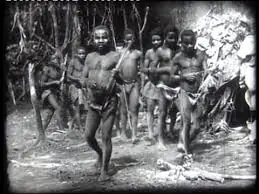Physiognomy of Africans vastly different then Eurasians apparent to the eye, but also measurable
physiognomy, the study of the systematic correspondence of psychological characteristics to facial features or body structure. — Britannica.com
 by Martha Christina, South Africa
by Martha Christina, South Africa
Pygmies could well be a modern Homo naledi, or at least have significant H-Naledi admixture.
From the Milwaukee Journal, September 10, 2015,
New species of human found in South African cave
Homo naledi stood about 5 feet in height, roughly the size of an African pygmy, with long legs and ape-like shoulders, hands and feet similar to our own, but a brain only one-third the size.
Pygmy Morphology
 The shape at the back of the head in pygmies will be closer to Homo naledi than in the San.
The shape at the back of the head in pygmies will be closer to Homo naledi than in the San.
The larger Pygmies have a rounded shape at the back of the head than the smaller Pygmies. So the Hazda will have other genetic contributions as they physically tend to be larger than the smaller Pygmies. The ‘large Pygmies’ have more varied features than the smaller Pygmies. There are some South Africans who have remainder DNA from smaller Pygmies here.
UPenn genetics researcher Sarah Tishkoff PhD believes Pygmies small stature may not be related to natural selection factors. Dr. Tishkoff also notes Pygmies have very unique genetics not found in other modern human populations.
From PennToday, May 2012,
Penn geneticist researches what makes Pygmies short
 Tishkoff’s team looked more specifically for genes with a role in height regulation, they identified a handful of promising candidates in what she calls a “hot spot” of chromosome 3.
Tishkoff’s team looked more specifically for genes with a role in height regulation, they identified a handful of promising candidates in what she calls a “hot spot” of chromosome 3.
These genes appear to do more than control height; they may also play a role in crucial biological functions, such as fortifying the immune system to protect Pygmies from infectious diseases, which are rife in the tropical areas they call home.
“The intriguing possibility this raises is: Could natural selection for short stature have nothing to do with short stature itself?” Tishkoff asks.
“What causes a Pygmy to be short may be very different from what causes a European to be short,” she says, “so we can learn something new from looking at ethnically diverse populations.”
As a biologist from the University of Edinburgh in Scotland points out, Pygmies having a distinct genome does not make them any less human.
From Quora.com, 2022, Claire Jordan, BA Biology, Univ. of Edinburgh,
Are African pygmies a different sub-species?
 Maybe. Pygmies (each different kind of pygmy) are the only human groups whose characteristics are distinct and sharp-edged enough that they might possibly qualify them as a sub-species.
Maybe. Pygmies (each different kind of pygmy) are the only human groups whose characteristics are distinct and sharp-edged enough that they might possibly qualify them as a sub-species.
Note that if they do qualify as a sub-species that does not IN ANY WAY make them less human than anyone else, it just means they have sharply-defined characteristics which differentiate them from other groups…
Note – Claire Jordan’s blog, Whitehound.
KhoeSan
San have a rounder shape at the back of the head than the Pygmies. Naledi did not have such a round shape to the back of the head. So I would say Pygmies and Naledi are closer and then another thing in between may be in the San.
From academic.oup.com, July 2020, Mattias Jakobsson, et.al…
Khoe-San Genomes Reveal Unique Variation and Confirm the Deepest Population Divergence in Homo sapiens
 We sequenced 25 full genomes from five Khoe-San populations, revealing many novel variants, that 25% of variants are unique to the Khoe-San, and that the Khoe-San group harbors the greatest level of diversity across the globe.
We sequenced 25 full genomes from five Khoe-San populations, revealing many novel variants, that 25% of variants are unique to the Khoe-San, and that the Khoe-San group harbors the greatest level of diversity across the globe.
In line with previous studies, we found several gene regions with extreme values in genome-wide scans for selection, potentially caused by natural selection in the lineage leading to Homo sapiens and more recent in time. These gene regions included immunity-, sperm-, brain-, diet-, and muscle-related genes
It is possible that the Xu San have less Homo naledi in than the Kwe San. The eye shape and the mouth shape in the Kwe San of the Central inland Cape is different from the Xu San. The 1 group has more slanted eyes and the other group has more beady eyes.
Zulu
 Some of the Zulu people in my local area do have a more oval shaped face. The more central and closer to Nongoma area and Ulundi area they are. And those along the Umhlanga coast.
Some of the Zulu people in my local area do have a more oval shaped face. The more central and closer to Nongoma area and Ulundi area they are. And those along the Umhlanga coast.
The others who live in the Piet Retief region and Paulpiet region of small towns have the square face. This is based on my observations of them when we drove from the Vryheid area to the Pretoria.
The most southern typical Zulus have the extreme brow ridge – the ones who live further away from the East coast of Southern Africa. The ones closer to Durban and East Cape have a less pronounced brow ridge and more oval face.
The Zululand group Zulu royalty have a more oval shaped face than the lower class group.but the leg shape of the naledi seems to have been passed on to one of the types of South African Nguni groups. Not all Nguni have that much naledi.
Some Nguni have more Nilote DNA and have an East African feature but others have the real Central African Bantpid Bantoid feature with a very protruding mouth shape and wider mouth. And larger resonance space inside the skull. Some have a rounder head shape than others. The jaw is narrow in the Nilotic derived Zulu and wider and slightly square in the other type Zulu. The ine group has a smaller brow ridge than the other
Nilotes
The Nilotes and Alur Africans will have less Homo naledi DNA than the Congid and Pygmies.
Britannica:
 Nilot, plural Nilotes, any member of several east-central African peoples living in South Sudan, northern Uganda, and western Kenya. The name refers to the area in which they live, mostly the region of the upper Nile and its tributaries, and to a linguistic unity that distinguishes them from their neighbours who have similar physical characteristics and culture.
Nilot, plural Nilotes, any member of several east-central African peoples living in South Sudan, northern Uganda, and western Kenya. The name refers to the area in which they live, mostly the region of the upper Nile and its tributaries, and to a linguistic unity that distinguishes them from their neighbours who have similar physical characteristics and culture.
Some Proto Congids mixed with Pygmies and this created the first Neo Ntu. The pre Ntu group who lived in the swampy area of ancient Nigeria could have had other species DNA than the Pygmies.
From Africa 101 Last Tribes blog:
Alur are a Nilotic ethnic group who live mainly in the Nebbi, Zombo, and Arua districts in northwestern Uganda, and northeastern Democratic Republic of the Congo (DRC), north of Lake Albert.
They are part of the larger Luo group, and their language is closely related toAcholi. Some Alur speak Lendu.
The Ntu group then became aggressive and attacked Pygmies and took Pygmies wives which changed the morphology of the then Ntu and created the modern sub Ntu or new Ntu. That is how it got into the Ntu group. There are some Ntu groups who are less Naledi than others in their features.
Note – Martha Christina lives near the coast in South Africa. She is a teacher of English. She is also the Host/Moderator of the Gab Human DNA & Genetics group with over 400 members.
As someone who thought that Koko the Gorilla was Serena Williams’ prettier sister, I still have to advise caution against physiognomic conclusions.
Morphological ambiguities can mislead a specimen’s true evolutionary heritage and provide a breeding ground for interpretive bias.
As of today there is no scientific evidence that the Red Deer Cave people were closer kin to archaic humans than anyone reading this.
Oliver looked like a bizarre hybrid but was just another chimpanzee under the skin.
Modern Flores Island pygmies are no more closely related to Homo floresiensis than was Andre the Giant.
It seems to me that there is much sound support for the subspecies hypothesis.
But in my opinion, it is unwise to assign a naledi heritage to some modern Africans before there is actual genetic evidence for it.
If those claims don’t pan out it could taint subspecieism in the minds of some who might otherwise have been open-minded.
Duncan makes a good point that we need to see the genetic evidence before we make any claims for subspecies,.
However, is there already genetic evidence that the powers that be don’t want us to see, and won’t release, and is that the reason the NIH is banning all access to genetic research studies, so that any scientific truth about Human Evolution, that questions the dominant Political Correct Narrative that we are all brothers under the skin, science will be suppressed, to protect a politically based lie?
Yes, Erik, there is such genetic evidence. Recent papers [https://www.science.org/doi/10.1126/science.abb6460 “The evolutionary history of Neanderthal and Denisovan Y chromosomes” Petr, et al, March 2020], and [https://www.nature.com/articles/ncomms16046 “Deeply divergent archaic mitochondrial genome provides lower time boundary for African gene flow into Neanderthals” Posth, et al, July 2017], show that Denisovans, NEA (Neanderthals), and AMH (anatomically modern humans), all diverged from H. Heidelbergensis, AMH and NEA splitting Heidelbergensis into two separate populations. Since it has not been shown that NEA ever lived in Africa, that divergence did not happen in Africa. Besides that proof of Eurasian genesis it is shown that both uniparental DNA packages, Y DNA and mtDNA, from AMH entirely replaced those in NEA over hundreds of millennia, showing the coexistence of AMH and NEA during that time in Eurasia.
The OoA (out of Africa) hypothesis that all funding for anthropological and archaeological research supports was only ever based on calculations of mutation rates from modern DNA samples. Both papers above cited refine that molecular clock data and disprove OoA using ancient DNA, not merely estimations from modern DNA. Further, the timeline for the ‘African Eve’ is right when Toba erupted. People living in the path of destruction all across S. Asia would have had to flee that catastrophe or perish, and Africa was relatively unaffected. AMH entered Africa then (~73kya), seeking refuge, and emerged as soon as possible to start that molecular clock ticking. It is ludicrous to suppose that AMH emerged from Africa just at the Toba catastrophe, leaving a refuge from the effects of the eruption and heading straight into the devastation, and this is what we are given by OoA.
Upon rational examination of the evidence today, it is impossible to conclude AMH arose in Africa. Despite these facts, you will note that both cited papers continually refer to AMH coming out of Africa (despite disproving that happened), because they know where the butter on their bread comes from.